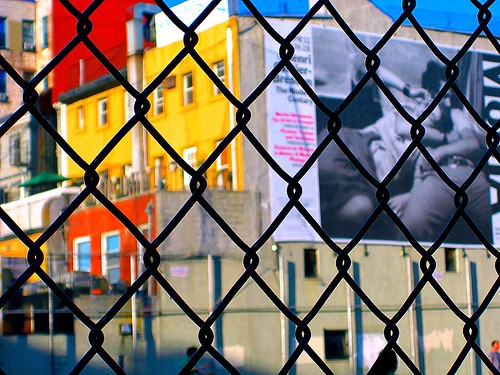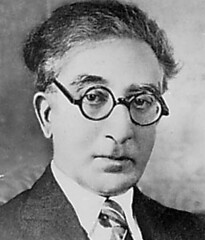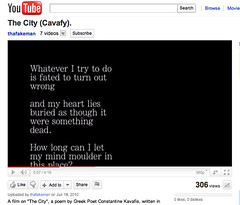Cities are unforgiving places, and New York perhaps the least forgiving of all.
One of its less attractive traits has always been its self-mythologizing triumphalism and I ♥ NY campaigns, a localized form of the nationalism it derides in the rest of the country. “If I can make it there, I’ll make it anywhere,” Frank Sinatra sang in what has become Manhattan’s unofficial national anthem and New Year’s rallying cry. It’s a sentiment to which countless scrambling citizens still subscribe. If they can just work hard enough, be ingenious and ruthless enough, they too will be “king of the hill / Top of the heap,” because this is the place. Or so we like to think.
Is it, though? Just over a century ago, C.P. Cavafy (1863-1933), an enduringly popular Greek poet who lived in Alexandria, Egypt, wrote a 16-line poem called “The City” which immortalizes a peculiarly urban dilemma whose outlines disenchanted New Yorkers will readily recognize. Those who have just moved here should read the poem, memorize it, print it out, and stick it on the fridge door.
From a New Yorker’s viewpoint, the most startling aspect of Cavafy’s poem, which like all his work is devoid of metaphor, similes or any other poetic flourishes, is that it turns Sinatra’s myth on its head. What Cavafy is saying is that if you can’t make it here, or more accurately, if after a period of time you discover you haven’t made it here — although bear in mind his subject was personal contentment rather than riches and fame — you won’t be able to do so anywhere else either. It will be too late. Which to a New Yorker, living on the planet’s most competitive island, is a bracingly disturbing thought. That isn’t just turning Sinatra’s lyric on its head, that’s breaking its neck. Even if, chronologically speaking, Cavafy did so before it had been composed.
Taking up a mere 16 plain-spoken lines, “The City” is one of the most unsparingly lucid texts about urban existence ever written. The metropolis of Cavafy’s poem is universal, and pertains as much to New York in 2011 as it did to Alexandria in 1911. In fact, one of the many translations of Cavafy’s poetry published in English (the Rae Dalven translation) comes with an introduction by W.H. Auden, who was living at 77 St. Marks Place when he wrote it in 1961.
Auden, who moved here from England in 1939, had his own problems with New York: “My kitchen roof leaks. Cockroaches abound. O New York!” he wailed in a letter 35 years after his arrival. His toilet, like so many tenement toilets, didn’t work properly, so during a winter freeze, the man widely regarded as the greatest poet in the English-speaking world was forced to use the one in the liquor store around the corner. Summing up Auden’s East Village predicament, the writer Frederic Prokosch wrote: “The pain becomes an addiction just as heroin becomes an addiction…. He has sunk into this nostalgie de la boue” — yearning for the mud — “and he isn’t the only one, there are thousands of others in this devastating city.”
So let us grant at least a tiny connection between this poem and this neighborhood. The translation used here is by Edmund Keeley and Philip Sherrard, and is divided into two matching parts of eight lines each. In the first, an unnamed person tells the poet what has happened to him – to his life, his aspirations – in the city, and none of it has been good. He is one of those burned-out souls who dreams constantly of escape. “I’ll go to another country, go to another shore, / find another city better than this one,” he states. For he sees no point in remaining where he is:
“How long can I let my mind molder in this place?
Wherever I turn, wherever I happen to look,
I see the black ruins of my life, here,
where I spent so many years, wasted them, destroyed
them totally.”
How many New Yorkers, grown weary of their lot, stowed away in tiny apartments with their sorrows and pets, have secretly voiced these very sentiments? And how many have deflected their internal misery onto the ever-changing metropolis around them? Is the essential alteration in you or in the environment or both? Cavafy offers no solution to this eternal conundrum, and zero consolation. On the contrary, his outlook is cosmically harsh, as if an unforgiving god were speaking rather than a poet.
“I’ll go to another country, go to another shore,” the speaker had said in the poem’s opening. Now Cavafy answers him with an outright rebuttal: “You won’t find a new country, you won’t find another shore.”
The city will always pursue you. You will walk
the same streets, grow old in the same neighborhoods,
will turn gray in these same houses.
The city, in Cavafy’s view, is not merely an agglomeration of people and history and events and streets, it is a state of mind, an extension of the self. His final lines offer no consolation or hope whatsoever to the would-be escapee:
You will always end up in this city. Don’t hope for
things elsewhere:
there is no ship for you, there is no road.
As you’ve wasted your life here, in this small corner,
you’ve destroyed it everywhere else in the world.
It is as un-American a viewpoint as one could find, at least in the America of today. One cannot discard the past or a no longer useful self with the airy ease that popular New Age gurus such say we can. My mind tells me Cavafy is misguided, that his fatalism is the exaggerated product of an antique era and sensibility, and that a fresh start is always possible. So why does his poem have such power?
Searching for an answer to that question, I looked up William Faulkner’s famous line (“The past is never dead. In fact it’s not even past.”) to get the exact wording, and while doing so found another, even more apposite line of Faulkner’s, at least as far as Cavafy’s poem is concerned. “The poets are wrong of course… But then poets are almost always wrong about facts. That’s because they are not really interested in facts: only in truth: which is why the truth they speak is so true that even those who hate poets by simple and natural instinct are exalted and terrified by it.”
Another answer is that I first read “The City” in Lawrence Durrell’s great free rhyming translation (included in “The Alexandria Quartet”) when I was in my teens – and never forgot it. But then who could forget lines like these?
There’s no new land, my friend, no
New sea; for the city will follow you,
In the same streets you’ll wander endlessly,
The same mental suburbs slip from youth to age,
In the same house go white at last –
The city is a cage.
It’s that final line — “The city is a cage” — which has always stuck with me, and with good reason: The island city of Manhattan, bound by the towering steel bars of its skyscrapers, is perhaps the most enticingly dangerous city-cage of all.







